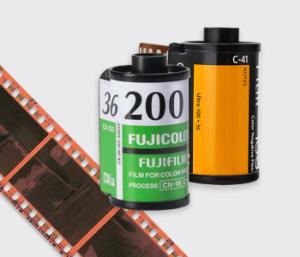

This item is one roll of 36-exposure 35mm (135) film. Its high degree of sharpness and fine grain structure is also particularly well-suited for scanning. The slow speed of the film offers extensive control over the highlight regions of a scene, maintains accurate, yet dynamic, colors, and is ideal for portraiture and landscape photography.
#C41 FILM 35MM ISO#
If exposing under tungsten/3200K-balanced lighting conditions, an 80B filter is recommended along with exposing the film at ISO 12 for normal results. Utilizing a unique "Premoval" stage, the traditional anti-halation rem-jet layer has been removed from this film, enabling its development in C-41 chemistry as well as the motion picture standard ECN-2 process.īenefitting from the distinct qualities of a low-speed motion picture stock, this daylight/5500K-balanced film is well-suited for outdoor shooting in bright conditions and exhibits a nominal sensitivity of ISO 50/18°.
#C41 FILM 35MM MOVIE#
With these films, in a C-41 process, the silver image is bleached away and the dye cloud negative image remains, just as with C-41 color films.Producing a cinematic image quality for still photographers, the Cinestill 50Daylight Xpro C-41 Color Negative Film is re-formatted movie stock that has been prepared and packaged for use in still cameras. These are essentially color films, but instead of three layers with filtration and different dye couplers, these films have a single layer of sensitive emultion, no filter layer(s), and dye couplers balance to produce a black image (by producing all three dyes in visually equal amounts). The only other way to get a B&W negative with a color process is to use a so-called "chromogenic" B&W film, like Ilford XP2 Super or the Kodak equivalent. With no dye couplers in your B&W film, you won't get a dye cloud image, but if you don't bleach the silver, you'll still get a silver negative images, just like what you'd get in D-76 or Rodinal. Any color developer will produce a silver image in any conventional film - but standard color processes bleach away the silver to leave only the color dye clouds that form the final (either positive or negative) color image. You will receive digital scans and negatives. There's one "color" process that might have produced an image like the one shown (though it appears the negative was "distressed" in some manner as well): that's developing with any of the three developers, C-41, E-6 First Developer, or E-6 Color Developer, then stopping and fixing with non-bleaching fixer (like conventional B&W fixer or C-41 fixer, not blix), without going through the bleaching step (often combined with fixing in home color developing kits). This service covers the developing & scanning of one roll of 35mm format color negative film (C-41).


The secret is in how colour coupling works on a silver image.

Developing a Black & White film as colour film will leave a dye image rather than a metallic silver one.


 0 kommentar(er)
0 kommentar(er)
